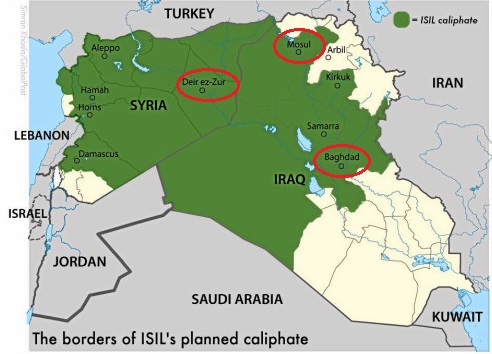Why in news?
Trump had announced that a commando raid in Syria had resulted in the death of Islamic State founder-leader Abu Bakr al-Baghdadi.
What happened?
- The raid was the culmination of years of steady intelligence-gathering work.
- Baghdadi was hiding in a village in Idlib, the Syrian province controlled by al-Qaeda-linked jihadists and pro-Turkey rebels.
- The helicopters flew, ferrying U.S. special forces to the compound where Baghdadi was hiding.
- U.S. President Donald Trump watched the raid in real time via a video link.
- The troops blasted into the hideout.
- Mr. Trump said that Baghdadi blew himself up in a tunnel while he was surrounded, killing himself and three of his sons.
Who is Baghdadi?
- Baghdadi rose to international notoriety in July 2014.
- He appeared in the podium of Mosul’s Grand al-Nuri mosque as the leader of the new ‘Caliphate’ announced by his group.
- At the height of its power in 2014, the Caliphate controlled territories as large as Great Britain spanning the Iraqi-Syria border.
- The Caliphate spread from Deir Ezzor in eastern Syria to Mosul in northern Iraq and with Raqqa its de facto capital.
- It drew in radicalised young Muslims world-wide into its fold.
- It fought the Syrian and Iraqi national armies as well as rebel groups in Syria.
- The Caliphate unleashed violence against anyone who disagreed with its version of Islam and against minority groups in Islam and non-Muslims.
- Baghdadi presided over the rise of his group as a death cult, bringing back memories of medieval religious conflicts.

How did the IS take shape?
- When Abu Musab al-Zarqawi was killed by the U.S in 2006, it was a setback to the al-Qaeda in Iraq (AQI), the organisation that he led.
- After his death, Sunnis in northern Iraq rose against the AQI.
- This, along with a surge in U.S. troops in Iraq, pushed the group to retreat from the cities and towns.
- But it did not finish the AQI off.
- Syria began plunging into chaos in the early days of the civil war in 2011.
- In this backdrop, the AQI, under Baghdadi’s leadership, morphed into a bigger, more powerful terrorist machinery - the IS.
What are the challenges ahead?
- What happened to the IS now is similar to what happened to the AQI then.
- The Baghdadi Caliphate was a short-lived phenomenon.
- The cities the IS once ruled were liberated, and it’s jihadists are on the run.
- Now that Baghdadi is also gone, the IS is at the weakest point of its short history.
- Nevertheless, the conditions that gave rise to the Islamic State still remain.
- The IS, like its peers in global jihadism such as al-Qaeda, is not a completely leader-dependent organisation.
- It is fundamentally an insurgency comprising ideologically linked autonomous cells and loyal to one leadership.
- So despite Baghdadi’s death is a blow to the IS and its propaganda, it does not mean that IS operations are over.
- Also, the geopolitical conditions that led to the IS’s creation have not changed much.
What is the way forward?
- With the IS’s double loss, the focus should now be on stabilising Iraq and Syria.
- Efforts should be on to end the conditions that led to the rise of the AQI and the IS.
- This is crucial to make Baghdadi’s death meaningful in the global fight against terrorism.
Source: Indian Express, The Hindu
